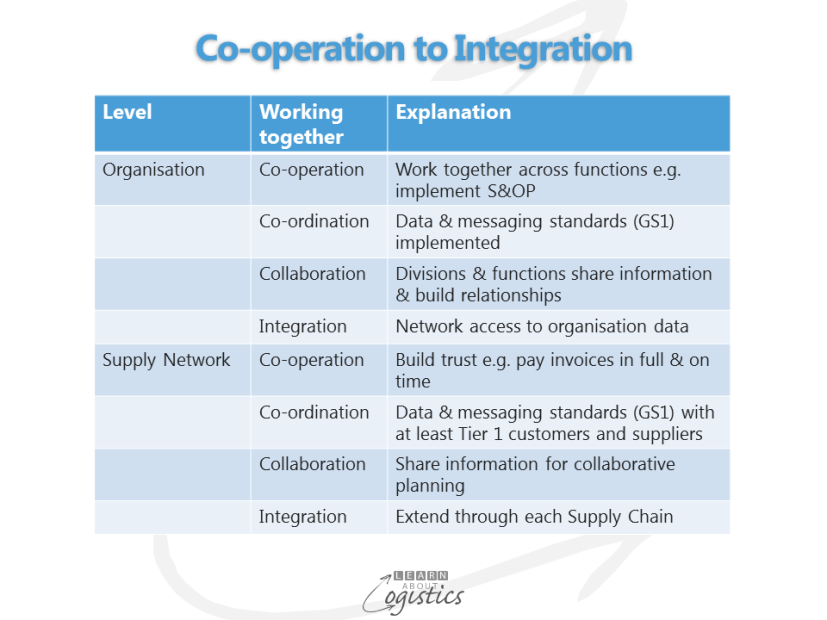A vision to understand.
Industry 4.0 appears to be a term gaining favour in the media for the next transformation of how materials and items are made and delivered. The term Digital Supply Chain is also being pushed. Are they the same or different?
As with any new idea, there is a multiplicity of definitions. The Learn About Logistics versions are:
- Industry 4.0: ’the digitisation and network integration of all physical assets in an organisation and its integration into a digital network with parties in the organisation’s supply network’
- Digital Supply Chains (DSC): ‘integration of physical and digital asset data and information bidirectionally between nodes and links in an organisation’s supply network, as the driver of physical production and distribution’
If DSC was changed to Digital Value Chains (that is, demand chain plus supply chain), then Industry 4.0 and Digital Value Chains would appear to be very similar. Industry 4.0 was proposed in Germany in 2011 as a vision for manufacturing and has since been enlarged. It is seen by proponents as a logical progression of developments in industry. The four major Industries are:
Industry 1.0: Mechanisation. Steam and water power. New manufacturing – metallurgy (i.e. iron), textiles
Industry 2.0: Electrification and gas. Mass production and production lines, engines and turbines, Globalisation 1.0, telegraph communications
Industry 3.0: Digitisation and automation. Operations technologies – real time computers, machine controls (programmable logic controllers – PLCs), robots. Information technology, digital networks and Internet. Globalisation 2.0
Industry 4.0: Convergence of information technology and operations technology. An organisation’s supply chains are restructured as a digital supply network, accepting entirely different methods to achieve the flow of physical items (material, resources and people), money, transactions and information
The broad elements of Industry 4.0 and Digital Supply Chains are:
Supply Chains (Industry 4.0 and DSC)
- Flows of materials and items through inbound, internal and outbound supply chains of an organisation
- Digital supply chains rely on real-time data, not the current model of batch updates of data followed by manipulation
- Operations Planning of materials and item flows influenced by the extent of bidirectional data and information
- MES (manufacturing execution system), WMS (warehouse management system) and TMS (transport management systems) have a central role as the digital hubs of connectivity and data collection/analytics
- Maintenance management systems with sensor based data collection and analysis capability for Predictive Maintenance
- Building management systems – energy management and efficiency
- Equipment and Facilities utilise Internet of Things (IOT) technology
- External data and information integration with at least Tier 1 customers and suppliers
- Requires co-operation and co-ordination (that is trust) between the parties
Marketing (Industry 4.0)
- Digitisation of product and service offerings wherever applicable
- Digital business models to optimise customer interaction and access
Importantly, Industry 4.0 and DSC are a vision, not a methodology. This will require organisations to understand how the holistic vision could be implemented within their enterprise and its supply network. It is not a short exercise.
Working towards Industry 4.0/DSC is a progression from Industry 3.0. Real-time computing and PLCs (programmable logic controllers) have been used for fifty years to monitor and control industrial and distribution activities. They drove the Computer Integrated Manufacturing (CIM) vision of the 1980s, which fizzled out, because insufficient effort was put into the organisation and people elements.
Implementation will take longer than promoted
The hype surrounding Industry 4.0/DSC is understandably promoted by those who will benefit from its implementation – technology companies, consultancies, some academics and journalists. The FUD (fear, uncertainty and doubt) sales technique is used to enhance the ‘fear of missing out’ among potential customers and clients. A recent example of FUD is an article written by a technology supplier, stating that “46 percent of all manufacturers in SE Asian countries that are members of the Asia Pacific Economic Co-operation (APEC) forum will be fully connected internally by 2022″ (my italics). Does this statement pass the ‘is it for real’ test?
While technology developments will continue and more industrial products and applications become available, there are barriers to the hype associated with fast acceptance and implementation of Industry 4.0/DSC. Examples are:
- Industry 4.0/DSC will be a 20 year journey for an enterprise, not a single project. Building the vision for a digitised supply network will take time and require a visionary CEO and/or group of like-minded executives. If you are the lone supply chain executive carrying a flag for Industry 4.0/DSC, it is likely to be a career limiting decision; instead, cultivate other executives to join the cause – and that takes time
- In many countries, about 80 percent of manufacturing and distribution businesses are small, with less than 20 employees. Companies with an annual turnover below U$50m are unlikely to have the time or resources to assess methodologies, processes, technologies and techniques to develop a complete Industry 4.0/DSC strategy
- Implementation of Industry 4.0/DSC will more likely be through a number of focused, defined, affordable and achievable projects, assessing technologies available at the time, as new open source software applications and hardware solutions become available. The need in each project is for connection to the network, whenever required – and that requires adherence to standards
- A Supply Chain or Network has its own dynamics – it is a complex, adaptive system. As there is not a ‘network controller’ managing, controlling or optimising the events in an organisation’s supply network, it is only when the network is digitally integrated can an organisation be totally confident that decisions will be ‘right’. However, suppliers and customers through each supply chain are independent entities, so integration of supply chains is more likely to be a hope rather than a reality
- Before achieving integration of a supply network, organisations must achieve internal co-operation and co-ordination, then achieve the same with (at least), their critical Tier 1 suppliers and customers. Has your organisation achieved internal and external integration shown in the table?

- Three letter acronyms such as Enterprise Resource Management (ERP), Customer Relationship Management (CRM) and Supplier Relationship Management (SRM) will be a part of organisations for many years into the future. However, each is an internal enterprise application – not suitable as connectors within supply (or B2B) networks
These comments indicate that companies are more likely to be slower than the hype suggests for accepting and implementing the holistic vision of Industry 4.0/DSC. Technology driven change will happen in your industry, but there are few companies where owners and shareholders will accept years of losses to achieve a vision.

